Score Adjustments
MORE DIRECTOR MODE SETTINGS
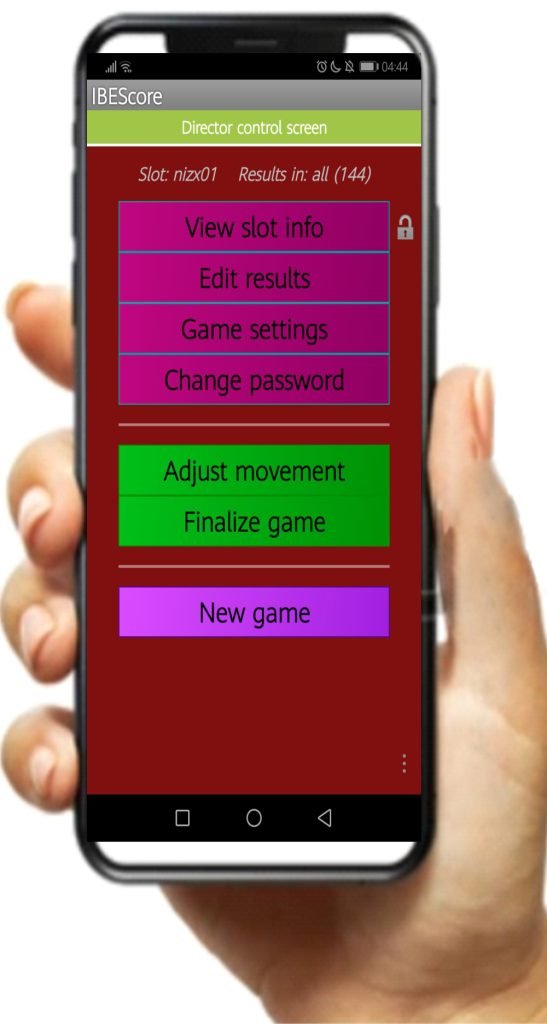
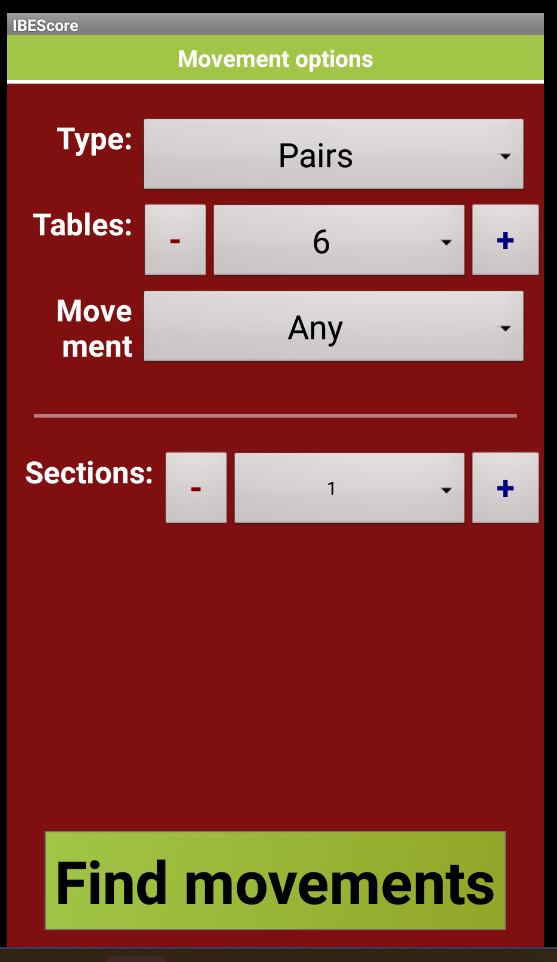
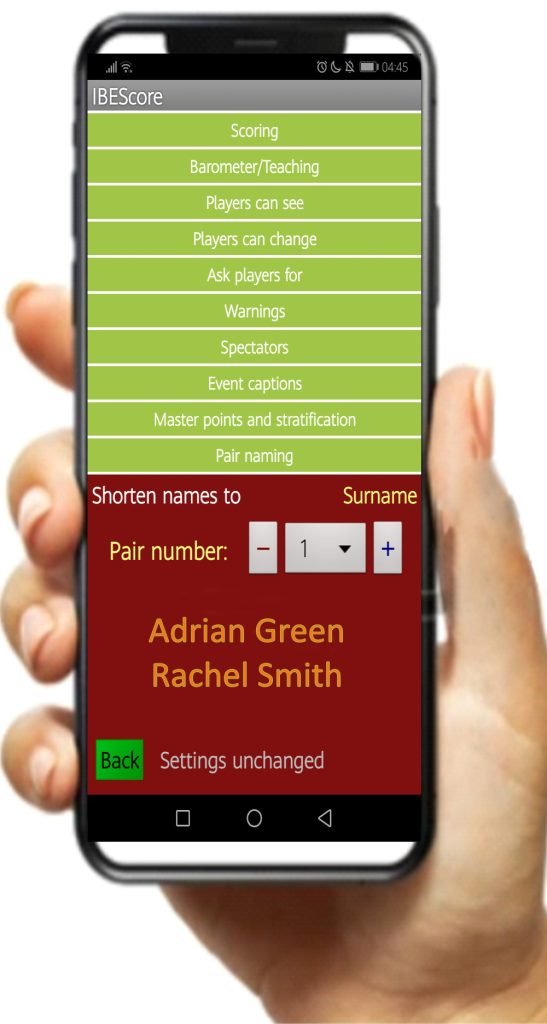
Entering an artificial adjusted score
To award an artificial adjustment, or to record that a board has been played in the wrong orientation, tap and hold the quick-adjust button >>>>. A menu will appear, from which you can choose the adjustment you want.

Correcting results during a round
As long as the device is still in the current round, the player who entered the wrong score can cancel it and re-enter the correct score. Director MODE is only required if the devices has moved on into the next round.
Tap the BACK button on the device until you can see either the score entry screen or the end of round screen. Tap the IBEScore icon and click REFRESH.
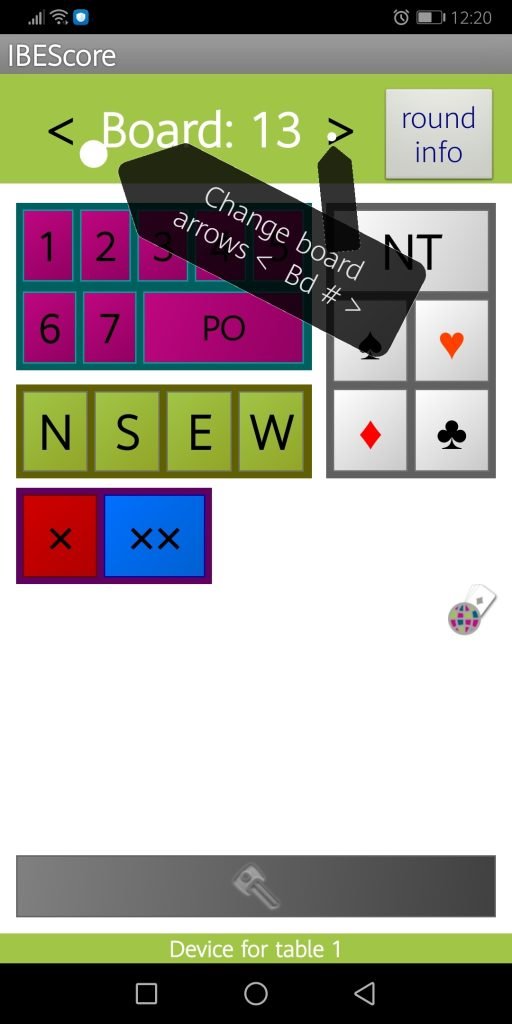
- On the score entry screen, tap the change Board < or > symbols to step through the boards until you find the board to be corrected.
- If you can see the “End of round” screen, tap the “Review last round” button, and tap the “Cancel”.
- To cancel the score, tap “cancel”, and confirm by tapping “Yes” in the pop-up. Now enter the correct score.
If you cannot see any of these options DIRECTOR MODE will likely be needed to correct the score.
NB: In Director Mode the organiser can remove/allow users to cancel scores during a round via the Game Settings
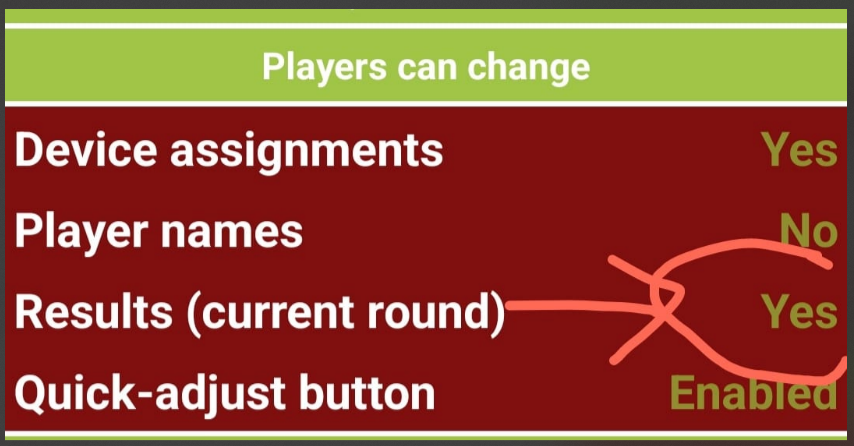
Adjusting a score after the round ended
When you need to correct or adjust a result after the players have moved on from the round when it was played, or after the end of the event, you need to be in the director mode.
- Log in as director
- Tap “Edit results”. This will take you to the Edit options screen.
- Tap “Adjust a result”
- Navigate to the result using the +/- controls or click for lists. Use the top control + to select the board, and then use the bottom control to choose which play of the board you wish to change.
- To cancel the score, tap “Clear”, and confirm by tapping “Yes”. If desired, you can now input a corrected score immediately by tapping “Enter result”.

To award an artificial adjustment, or to record that a board has been played in the wrong orientation, tap the green “Adjust” button. This will bring up the adjustment screen. Use the controls to select the type of adjustment as applied to N/S, and the adjustment applied to E/W.


- To specify that a board was played in the wrong orientation, select the “Reverse” item from the control for N/S and E/W.
- To remove a board from play entirely, select the “Delete from movement” item.
- If the adjustment has a numeric parameter, eg 60% of matchpoints, tap-type the number (eg 60) into the text field below the adjustment type.
- To award a “zero-sum” adjustment, specify the adjustment for N/S and then tap “Balance”. This will impose an E/W adjustment which is the complement of the N/S adjustment, i.e. both no-play, or both reverse, or matchpoints summing to 100%, or IMPs summing to zero, etc.
- To tell system that for example a different pair played a board as EW, but NS remain unchanged it is necessary to assign the same pair number to NS and the new Pair Number to EW in order to activate the Apply button.
When you have finished specifying the adjustment, tap “Apply”.
If you don’t see the “Adjust” button for the board you have selected on the Edit options screen, (eg if no score has been entered) tap “Enter result”, and enter any fake score, eg a pass-out for the result. Tap “OK”. You will be taken back to the previous screen and the green “Adjust” button should now appear.
Splitting a board
If some cards are returned to a board in different pockets from the ones they were taken out of (eg with the North and West hands swapped, or with North and South having exchanged two cards) and the board is played multiple times in its new configuration, the laws of bridge say that the old and the new configurations should be scored as if they were two separate boards.
If the board is fouled yet again, then the third configuration becomes a separate board, and so on.
This is called Splitting a board.
IBEScore supports splitting boards. To specify that a board should be split, do the following:
- Log in as director.
- Tap “Edit results”, then “Split a board”
- Use the control at the top to specify the number of the board you want to split.
- Scroll through the list of plays of that board, and tap the first entry where the board was played in its second configuration. That entry, and all subsequent entries, should turn green.
- If multiple copies of the board are in play, only one of which was fouled, now tap the last entry where the board was played in its second configuration. The subsequent entries should revert to white.
- If a board was subject to a second fouling incident, tap twice the first entry where the board was played in its third configuration. After the first tap, it will turn white. After the second tap, it and all subsequent entries will turn yellow.
The end result is that each configuration of the board is represented by a different colour. The colour of a play denotes which configuration of the board which was in use at that time.
You can split a second or further boards by using the control at the top to switch between boards.
When you have finished specifying board splits, tap “Save”.
To discard the splits which you have specified, tap the green “Back” button or use your phone’s back button.
Altering the movement: Arrow switches, rovers, phantom pairs
This section deals with actions such as introducing an arrow-switch, a rover or a missing pair, or removing a round. These actions must be done in director mode.
Log in as director, and tap “Adjust movement” (or tap the movement menu option). This will bring up the movement screen.
You can now perform the following actions:
- Arrow switch a round: Tap on the round number at the head of that round’s table row, and select “Arrow switch”. You may not arrow-switch a round for which results have already been entered; clear these results first. To remove an arrow-switch which you introduced, simply repeat this action.
- Arrow switch a specific table in a round (all boards): Tap on the entry for the table in the appropriate round, and select “Arrow switch”. You may not arrow-switch if any results have already been entered for this match-up; clear any results first. To negate, simply repeat this action.
- Specify the missing pair: Tap “Players” at the top of the movement screen. Then go to “Missing pair” at the bottom and tap on the long button to the right. Select the missing pair number. You may not introduce a missing pair if the movement already has a rover; remove the rover first.
- Remove the missing pair: Tap “Players” at the top of the movement screen. Then go to “Missing pair” at the bottom and tap on the current missing pair number. Select “−“ from the menu which appears.
- Introduce a rover pair: Tap “Players” at the top of the movement screen. Then go to the bottom of the screen and click “Add rover”, or “Add cuckoo”. IBEScore refers to rovers as cuckoos for non-Mitchell movements, since they are stationary rather than moving. When adding a cuckoo, IBEScore will calculate the allowed table numbers and directions where the movement can admit the cuckoo pair, and prompt you to select one of them. Mitchell-movement rovers are seated in the standard locations given in eg Manning’s the EBU Manual of duplicate Bridge Movements. You may add a rover or cuckoo at any stage in the tournament and it will take effect immediately. Some movements do not admit a rover.
- Remove a rover pair: Tap “Players” at the top of the movement screen. Then go to the bottom of the screen and click “Remove rover”, or “Remove cuckoo”.
- Remove a round from the tournament: Tap on the round number at the head of that round’s table row, and select “Remove”. You will be prompted if you are sure. Deleting a round is permanent and cannot be undone.
You will not be allowed to perform an action which changes a part of the movement for which a result has already been entered. You can, however, clear those results and then perform the action.
Your changes to the movement will be picked up by each device the next time it is used to enter a score, or when an explicit refresh is done on it (tap “Menu”, then “Refresh game”). It is almost always ok to just allow client devices to pick up the movement alteration in their own time, particularly if it is done well in advance of the round which is being altered. Rarely there is a possibility that a result may be entered by a device for a matchup which has been altered before the alteration is reported to it. In this case the director can explicitly refresh the devices.
Boards per round
The boards per round are set during the game creation process. After selecting the movement, tap “Edit movement”, followed by “Boards” (near top of screen). Use the “Boards/round” spinner to modify the movement’s default boards per round, and produce a shorter or longer event.
You can then edit the number of boards in each individual round.
Entering results from paper travellers
You can enter results from paper travelers in quick succession, sending them to the server only at the end, rather than one by one. Entering scores can be done by more than one person at a time, allowing the travellers to be divided among several people each with their own device.
Log in as director. Tap “Edit results” followed by “Enter all results”. An options screen will appear.
Some travelers come with North-South pair numbers pre-printed in the first column. Other are blank, and North-South write their pair number on the first available line. Depending on which of these styles you have, make sure either “Enter results in N/S pair number order” (for the first type), or “Enter results in order played” (for the second type) is ticked.
We also recommend that “Show completed results” is ticked, at least the first time you enter results from traveler.
The tap “Go”.
The screen will now show a results entry layout. At the top of the screen is a label showing which traveler line is currently being entered.
Tap this label to switch between travelers by selecting from the list which appears.
Step through the lines on each traveller by swiping left or tapping the “Next” button. Stepping through from the last line of a traveler shows the first line of the next board’s traveler. Stepping from the last line of the final traveler goes back to the first line of board 1. To step back a line, swipe right or use the “Prev” button.
Enter the relevant score. If you are reading sequentially down a traveler, press “Next” to step through to the next one.
If the score you are about to enter is the same or similar to the last score you entered, consider tapping the “Repeat” button, and then making whatever small changes are necessary (eg an extra overtrick, or West instead of East). This can speed up the entry process for travellers which are quite “flat”.
If you are entering scores quickly, it can happen that you get out of step, and enter eg one result ahead of the one which IBEScore is anticipating. To help avoid this, the background colour changes:
- Red background: the first line of a traveller is always red.
- Green, blue background: other traveller lines alternate blue and green backgrounds.
Example: You are about to enter the last line of a traveller, and you see a red background. This tells you that you are out of step, since the red background marks the first line of the next traveller. You must have inadvertently tapped “Next” twice at some point. You need to step backwards (using “Prev.”) and find out which traveller line you skipped over.
At the top right corner of the screen, a count is shown of traveler lines which have still not been entered. If you have entered nearly all the traveler lines in your event, but are having difficulty identifying which ones you haven’t entered yet, tap and hold the “Next” button, and it will fast-forward to the next result which has not been entered, or for which the entry is incomplete.
After you have entered some scores, tap “Send all results” to commit them. If you are working as a team, you can now update your device with scores entered by your colleagues: tap the
Back button twice followed by the “Refresh”
At a certain point, your device or one of your colleagues will have all the scores in the event. You can now go back to the director screen and use the “Rankings” menu option to read off the winners. You can now finalise the game.
Finalising the game
This section deals with what to do when the event is finished.
First of all, double-check that all the results have been input.
- Tap the “Refresh” menu option
- Look near the top of either the director control screen or the rankings screen.
- The text should say Results in: all. If not, attempt to find any missing scores.
Optionally you may want to have a quick check there are no patently wrong scores. To do this:
- Log in as director.
- Use the “results” menu option, and tap the > button next to the board label to scan the travellers one by one.
- Traveller lines containing results which IBEScore thinks are unlikely will be highlighted in red. IBEScore judges that a result is unlikely if the tricks made are four more or fewer than that number suggested by the available trick analysis.
The next step is to prepare the results for publication. This is done using the green “Finalise game” button on the director control screen. Despite the name, “finalisation” is not “final”; you will still be able to make corrections if necessary.
Finalisation has the following effects:
- Preparing for publication: Finalising creates html and pdf files of the results, as well as files in csv and USEBIO formats which can be uploaded to Bridgewebs, Ecats and to national federation masterpoint aggregation servers eg EBU, SBU.
- Event backup: After an event has been finalised, it will be added to your list of historic events. Even after you create subsequent events, you will be able to restore the event in order to make corrections.
- Database update: Names of new players will be introduced to your account’s player database. Existing players will have their “last played” date updated. Partnerships, team names, and the event name will also be saved in the database so that they can be used as suggestions for future events.
Tap “Finalise game”. IBEScore will communicate with the internet for up to 30 seconds.
When finished, IBEScore will present the publication screen.